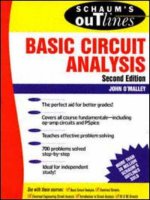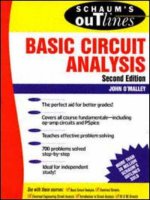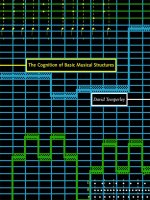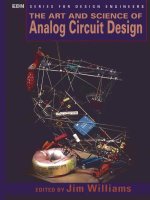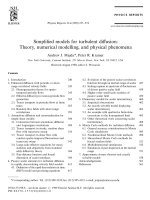J david irwin, r mark nelms basic engineering circuit analysis, problem solving companion wiley (2005)
Bạn đang xem bản rút gọn của tài liệu. Xem và tải ngay bản đầy đủ của tài liệu tại đây (1.58 MB, 170 trang )
Problem-Solving Companion
To accompany
Basic Engineering Circuit Analysis
Ninth Edition
J. David Irwin
Auburn University
JOHN WILEY & SONS, INC.
Executive Editor
Assistant Editor
Marketing Manager
Senior Production Editor
Bill Zobrist
Kelly Boyle
Frank Lyman
Jaime Perea
Copyright © 2005, John Wiley & Sons, Inc. All rights reserved
No part of this publication may be reproduced, stored in a retrieval system or transmitted in any form or by
any means, electronic, mechanical, photocopying, recording, scanning, or otherwise, except as permitted
under Sections 107 or 108 of the 1976 United States Copyright Act, without either the prior written
permission of the Publisher, or authorization through payment of the appropriate per-copy fee to the
Copyright Clearance Center, 222 Rosewood Drive, Danvers, MA 01923, (508) 750-8400, fax (508) 7504470. Requests to the Publisher for permission should be addressed to the Permissions Department, John
Wiley & Sons, Inc., 605 Third Avenue, New York, NY 10158-0012, (212) 850-6011, fax (212)850-6008,
e-mail:
ISBN 0-471-74026-8
TABLE OF CONTENTS
Preface……………………………………………………………………………………….2
Acknowledgement…………………..……………………………………………………….2
Chapter 1
Problems…………………..……………………………….……………………………………………3
Solutions…………………..…………………………………………………….………………………4
Chapter 2
Problems…………………..…………………………………………………….………………………7
Solutions…………………..…………………………………………………….………………………9
Chapter 3
Problems…………………..…………………………………………………….………………………18
Solutions…………………..…………………………………………………….………………………19
Chapter 4
Problems…………………..…………………………………………………….………………………25
Solutions…………………..…………………………………………………….………………………26
Chapter 5
Problems…………………..…………………………………………………….………………………31
Solutions…………………..…………………………………………………….………………………33
Chapter 6
Problems…………………..…………………………………………………….………………………42
Solutions…………………..…………………………………………………….………………………44
Chapter 7
Problems…………………..…………………………………………………….………………………50
Solutions…………………..…………………………………………………….………………………52
Chapter 8
Problems…………………..…………………………………………………….………………………66
Solutions…………………..…………………………………………………….………………………67
Chapter 9
Problems…………………..…………………………………………………….………………………73
Solutions…………………..…………………………………………………….………………………74
Chapter 10
Problems…………………..…………………………………………………….………………………82
Solutions…………………..…………………………………………………….………………………83
Chapter 11
Problems…………………..…………………………………………………….………………………88
Solutions…………………..…………………………………………………….………………………89
Chapter 12
Problems…………………..…………………………………………………….………………………94
Solutions…………………..…………………………………………………….………………………96
Chapter 13
Problems…………………..…………………………………………………….………………………103
Solutions…………………..…………………………………………………….………………………104
Chapter 14
Problems…………………..…………………………………………………….………………………111
Solutions…………………..…………………………………………………….………………………113
Chapter 15
Problems…………………..…………………………………………………….………………………127
Solutions…………………..…………………………………………………….………………………129
Chapter 16
Problems…………………..…………………………………………………….………………………136
Solutions…………………..…………………………………………………….………………………137
Appendix – Techniques for Solving Linear Independent Simultaneous Equations…………………………...146
2
STUDENT PROBLEM COMPANION
To Accompany
BASIC ENGINEERING CIRCUIT ANALYSIS, NINTH EDITION
By
J. David Irwin and R. Mark Nelms
PREFACE
This Student Problem Companion is designed to be used in conjunction with Basic
Engineering Circuit Analysis, 8e, authored by J. David Irwin and R. Mark Nelms and
published by John Wiley & Sons, Inc.. The material tracts directly the chapters in the
book and is organized in the following manner. For each chapter there is a set of
problems that are representative of the end-of-chapter problems in the book. Each of the
problem sets could be thought of as a mini-quiz on the particular chapter. The student is
encouraged to try to work the problems first without any aid. If they are unable to work
the problems for any reason, the solutions to each of the problem sets are also included.
An analysis of the solution will hopefully clarify any issues that are not well understood.
Thus this companion document is prepared as a helpful adjunct to the book.
3
CHAPTER 1 PROBLEMS
1.1
Determine whether the element in Fig. 1.1 is absorbing or supplying power and how
much.
-2A
12V
+
Fig. 1.1
1.2
In Fig. 1.2, element 2 absorbs 24W of power. Is element 1 absorbing or supplying power
and how much.
12V
+
+
6V
Fig. 1.2
1.3.
Given the network in Fig.1.3 find the value of the unknown voltage VX.
+ 4V + 10V 2A
1
2
6A
2A
4A
+
12V
+
-
3
8V
-
Fig. 1.3
+
-
VX
4
CHAPTER 1 SOLUTIONS
1.1
One of the easiest ways to examine this problem is to compare it with the diagram that
illustrates the sign convention for power as shown below in Fig. S1.1(b).
-2A
i(t)
+
12V
v(t)
+
-
Fig. S1.1(a)
Fig. S1.1(b)
We know that if we simply arrange our variables in the problem to match those in the
diagram on the right, then p(t) = i(t) v(t) and the resultant sign will indicate if the element
is absorbing (+ sign) or supplying (- sign) power.
If we reverse the direction of the current, we must change the sign and if we reverse the
direction of the voltage we must change the sign also. Therefore, if we make the diagram
in Fig. S1.1(a) to look like that in Fig. S1.1(b), the resulting diagram is shown in Fig.
S1.1(c).
2A
+
(-12V)
Fig. S1.1(c)
Now the power is calculated as
P = (2) (-12) = -24W
And the negative sign indicates that the element is supplying power.
1.2
Recall that the diagram for the passive sign convention for power is shown in Fig. S1.2(a)
and if p = vi is positive the element is absorbing power and if p is negative, power is
being supplied by the element.
5
i
+
v
-
Fig. S1.2(a)
If we now isolate the element 2 and examine it, since it is absorbing power, the current
must enter the positive terminal of this element. Then
P = VI
24 = 6(I)
I = 4A
The current entering the positive terminal of element 2 is the same as that leaving the
positive terminal of element 1. If we now isolate our discussion on element 1, we find
that the voltage across the element is 6V and the current of 4A emanates from the
positive terminal. If we reverse the current, and change its sign, so that the isolated
element looks like the one in Fig. S1.2(a), then
P = (6) (-4) = -24W
And element 1 is supplying 24W of power.
1.3
By employing the sign convention for power, we can determine whether each element in
the diagram is absorbing or supplying power. Then we can apply the principle of the
conservation of energy which means that the power supplied must be equal to the power
absorbed.
If we now isolate each element and compare it to that shown in Fig. S1.3(a) for the sign
convention for power, we can determine if the elements are absorbing or supplying
power.
i
+
P = Vi
V
-
Fig. S1.3(a)
For the 12V source and the current through it to be arranged as shown in Fig. S1.3(a), the
current must be reversed and its sign changed. Therefore
P12V = (12) (-6) = -72W
6
Treating the remaining elements in a similar manner yields
P1 = (4) (6) = 24W
P2 = (2) (10) = 20W
P3 = (8) (4) = 32W
PVX = (VX) (2) = 2VX
Applying the principle of the conservation of energy, we obtain
And
-72 + 24 + 20 + 32 + 2VX = 0
VX = -2V
7
CHAPTER 2 PROBLEMS
2.1
Determine the voltages V1 and V2 in the network in Fig. 2.1 using voltage division.
2kΩ
12v +-
+
4kΩ
3kΩ
+
V2
-
2kΩ
V1
-
Fig. 2.1
2.2
Find the currents I1 and I0 in the circuit in Fig. 2.2 using current division.
2kΩ
I1
6kΩ
3kΩ
12kΩ
9mA
I0
Fig. 2.2
2.3
Find the resistance of the network in Fig. 2.3 at the terminals A-B.
8kΩ
10kΩ
2kΩ
A
12kΩ
3kΩ
4kΩ
12kΩ
6kΩ
18kΩ
B
6kΩ
3kΩ
Fig. 2.3
2.4
Find the resistance of the network shown in Fig. 2.4 at the terminals A-B.
A
B
4kΩ
6kΩ
2kΩ
12kΩ
12kΩ
Fig. 2.4
18kΩ
12kΩ
8
2.5
Find all the currents and voltages in the network in Fig. 2.5.
2kΩ
A
10kΩ
B
I1
48V +
-
4kΩ
+
V1
I2
6kΩ
I3
I4
+
V2
-
2kΩ
3kΩ
I5
I6
+
V3
-
4kΩ
Fig. 2.5
2.6
In the network in Fig. 2.6, the current in the 4kΩ resistor is 3mA. Find the input voltage
VS.
2kΩ
VS
+-
2kΩ
1kΩ
4kΩ
3mA
Fig. 2.6
9kΩ
6kΩ
3kΩ
9
CHAPTER 2 SOLUTIONS
2.1
We recall that if the circuit is of the form
V1
R1
+
-
+
V0
-
R2
Fig. S2.1(a)
Then using voltage division
⎛ R2
V0 = ⎜⎜
⎝ R1 + R 2
⎞
⎟⎟ V1
⎠
That is the voltage V1 divides between the two resistors in direct proportion to their
resistances. With this in mind, we can draw the original network in the form
2kΩ
12V
+
-
+
3kΩ
V1
Fig. S2.1(b)
4kΩ
2kΩ
+
V
- 2
The series combination of the 4kΩ and 2kΩ resistors and their parallel combination with
the 3kΩ resistor yields the network in Fig. S2.1(c).
12V
2kΩ
+
-
2kΩ
+
V1
-
Fig. S2.1(c)
Now voltage division can be sequentially applied. From Fig. S2.1(c).
⎛ 2k ⎞
⎟⎟12
V1 = ⎜⎜
⎝ 2k + 2k ⎠
= 6V
Then from the network in Fig. S2.1(b)
10
⎛ 2k ⎞
⎟⎟ V1
V2 = ⎜⎜
⎝ 2k + 4k ⎠
= 2V
2.2
If we combine the 6k and 12k ohm resistors, the network is reduced to that shown in Fig.
S2.2(a).
I1
2kΩ
3kΩ
4kΩ
9mA
Fig. S2.2(a)
The current emanating from the source will split between the two parallel paths, one of
which is the 3kΩ resistor and the other is the series combination of the 2k and 4kΩ
resistors. Applying current division
I1 =
⎞
9⎛
3k
⎜⎜
⎟
k ⎝ 3k + (2k + 4k ) ⎟⎠
= 3mA
Using KCL or current division we can also show that the current in the 3kΩ resistor is
6mA. The original circuit in Fig. S2.2 (b) indicates that I1 will now be split between the
two parallel paths defined by the 6k and 12k-Ω resistors.
I1 = 3mA
6mA
2kΩ
3kΩ
9mA
6kΩ
12kΩ
I0
Fig. S2.2(b)
Applying current division again
⎛ 6k ⎞
⎟⎟
I 0 = I1 ⎜⎜
⎝ 6k + 12k ⎠
3 ⎛ 6k ⎞
I0 = ⎜
⎟
k ⎝ 18k ⎠
= 1mA
Likewise the current in the 6kΩ resistor can be found by KCL or current division to be
2mA. Note that KCL is satisfied at every node.
11
2.3
To provide some reference points, the circuit is labeled as shown in Fig. S2.3(a).
8k
10k
2k
A'
A"
A
12k
4k
3k
18k
6k
12k
B
3k
B'
6k
B"
Fig. S2.3(a)
Starting at the opposite end of the network from the terminals A-B, we begin looking for
resistors that can be combined, e.g. resistors that are in series or parallel. Note that none
of the resistors in the middle of the network can be combined in anyway. However, at
the right-hand edge of the network, we see that the 6k and 12k ohm resistors are in
parallel and their combination is in series with the 2kΩ resistor. This combination of
6k⎪⎢12k + 2k is in parallel with the 3kΩ resistor reducing the network to that shown in
Fig. S2.3(b).
8k
10k
A'
A"
A
12k
4k
2k = 3k (6k 12k + 2k)
18k
6k
B
3k
B'
B"
Fig. S2.3(b)
Repeating this process, we see that the 2kΩ resistor is in series with the 10kΩ resistor
and that combination is in parallel with the12kΩ resistor. This equivalent 6kΩ resistor
(2k + 10k)⎪⎢12k is in series with the 3kΩ resistor and that combination is in parallel with
the 18kΩ resistor that (6k + 3k)⎪⎢18k = 6kΩ and thus the network is reduced to that
shown in Fig. S2.3(c).
8k
A'
A
4k
B
6k
6k
B'
Fig. S2.3(c)
12
At this point we see that the two 6kΩ resistors are in series and their combination in
parallel with the 4kΩ resistor. This combination (6k + 6k)⎪⎢4k = 3kΩ which is in series
with 8kΩ resistors yielding A total resistance RAB = 3k + 8k = 11kΩ.
2.4
An examination of the network indicates that there are no series or parallel combinations
of resistors in this network. However, if we redraw the network in the form shown in Fig.
S2.4(a), we find that the networks have two deltas back to back.
A
B
4k
6k
2k
12k
12k
18k
12k
Fig. S2.4(a)
If we apply the ∆→Y transformation to either delta, the network can be reduced to a
circuit in which the various resistors are either in series or parallel. Employing the ∆→Y
transformation to the upper delta, we find the new elements using the following equations
as illustrated in Fig. S2.4(b)
18k
6k
R2 R1 R
3
12k
Fig. S2.4(b)
R1 =
(6k ) (18k )
= 3kΩ
6k + 12k + 18k
(6k ) (12k ) = 2kΩ
R2 =
6k + 12k + 18k
(12k ) (18k ) = 6kΩ
R3 =
6k + 12k + 18k
The network is now reduced to that shown in Fig. S2.4(c).
13
A
4k
3k
2k
B
2k
6k
12k
12k
Fig. S2.4(c)
Now the total resistance, RAB is equal to the parallel combination of (2k + 12k) and (6k +
12k) in series with the remaining resistors i.e.
RAB = 4k + 3k + (14k⎪⎢18k) + 2k
= 16.875kΩ
If we had applied the ∆→Y transformation to the lower delta, we would obtain the
network in Fig. S2.4(d).
4k
A
6k
18k
4k
4k
B
2k
4k
Fig. S2.4(d)
In this case, the total resistance RAB is
RAB = 4k + (6k + 4k)⎪⎢(18k + 4k) + 4k +2k
= 16.875kΩ
which is, of course, the same as our earlier result.
2.5
Our approach to this problem will be to first find the total resistance seen by the source,
use it to find I1 and then apply Ohm’s law, KCL, KVL, current division and voltage
division to determine the remaining unknown quantities. Starting at the opposite end of
the network from the source, the 2k and 4k ohm resistors are in series and that
combination is in parallel with the 3kΩ resistor yielding the network in Fig. S2.5(a).
14
10k
A
I1
48V +-
I2
+
V1
-
2k
6k
4k
I3
B
I4
+
V2
-
2k
Fig. S2.5(a)
Proceeding, the 2k and 10k ohm resistors are in series and their combination is in parallel
with both the 4k and 6k ohm resistors. The combination (10k + 2k)⎪⎢6k⎪⎢4k = 2kΩ.
Therefore, this further reduction of the network is as shown in Fig. S2.5(b).
2k
48 +-
I1
+
V1
-
2k
Fig. S2.5(b)
Now I1 and V1 can be easily obtained.
I1 =
48
= 12mA
2k + 2k
And by Ohm’s law
V1 = 2kI1
= 24V
or using voltage division
⎛ 2k ⎞
⎟⎟
V1 = 48 ⎜⎜
⎝ 2k + 2k ⎠
= 24V
once V1 is known, I2 and I3 can be obtained using Ohm’s law
V1 24
=
= 6mA
4k 4k
V
24
I3 = 1 =
= 4mA
6k 6k
I2 =
I4 can be obtained using KCL at node A. As shown on the circuit diagram.
I1 = I2 + I3 + I4
15
12 6 4
= + + I4
k k k
2
I 4 = = 2mA
k
The voltage V2 is then
V2 = V1 - 10kI4
⎛2⎞
= 24 − (10k ) ⎜ ⎟
⎝k⎠
= 4V
or using voltage division
⎛ 2k ⎞
⎟⎟
V2 = V1 ⎜⎜
⎝ 10k + 2k ⎠
⎛1⎞
= 24 ⎜ ⎟
⎝6⎠
= 4V
Knowing V2, I5 can be derived using Ohm’s law
V2
3k
4
= mA
3
I5 =
and also
V2
2 k + 4k
2
= mA
3
I6 =
current division can also be used to find I5 and I6.
⎛ 2k + 4 k ⎞
⎟⎟
I 5 = I 4 ⎜⎜
⎝ 2k + 4k + 3k ⎠
4
= mA
3
and
16
⎛
⎞
3k
⎟⎟
I 6 = I 4 ⎜⎜
⎝ 3k + 2k + 4k ⎠
2
= mA
3
Finally V3 can be obtained using KVL or voltage division
V3 = V2 − 2kI 6
⎛ 2 ⎞
= 4 − 2k ⎜ ⎟
⎝ 3k ⎠
8
= V
3
and
⎛ 4k ⎞
⎟⎟
V3 = V2 ⎜⎜
⎝ 4 k + 2k ⎠
8
= V
3
2.6
The network is labeled with all currents and voltages in Fig. S2.6.
+ V4 - I5 A + V2 - I3 B
2k
VS +
-
+
V3
-
I4
1k
2k
3
k
4k
6k
+
V1
I1
9k
I2
3k
Fig. S2.6
Given the 3mA current in the 4kΩ resistor, the voltage
⎛3⎞
V1 = ⎜ ⎟ (4k ) = 12V
⎝k⎠
Now knowing V1, I1 and I2 can be obtained using Ohm’s law as
V1 12
=
= 2mA
6k 6k
V1
12
=
= 1mA
I2 =
9k + 3k 12k
I1 =
Applying KCL at node B
17
3
+ I1 + I 2
k
= 6mA
I3 =
Then using Ohm’s law
V2 = I3 (1k)
= 6V
KVL can then be used to obtain V3 i.e.
V3 = V2 + V1
= 6 + 12
= 18V
Then
V3
2k
= 9mA
I4 =
And
I5 = I3 + I 4
6 9
+
k k
= 15mA
=
using Ohm’s law
V4 = (2k) I5
= 30V
and finally
VS = V4 + V3
= 48V
18
CHAPTER 3 PROBLEMS
3.1
Use nodal analysis to find V0 in the circuit in Fig. 3.1.
2mA
1kΩ
+
1kΩ
1kΩ
2kΩ
12V +-
V0
-
Fig. 3.1
3.2
Use loop analysis to solve problem 3.1
3.3
Find V0 in the network in Fig. 3.3 using nodal analysis.
12V
-+
2kΩ
2kΩ
1kIX +1kΩ
IX
+
V0
-
Fig. 3.3
3.4
Use loop analysis to find V0 in the network in Fig. 3.4.
2IX
1kΩ
1kΩ
+
4mA
1kΩ
IX
Fig. 3.4
2kΩ
V0
-
19
CHAPTER 3 SOLUTIONS
3.1
Note that the network has 4 nodes. If we select the node on the bottom to be the
reference node and label the 3 remaining non-reference nodes, we obtain the network in
Fig. S3.1(a).
2
k
V0
V2
V1
12 +-
1k
1k
1k
2k
Fig. S3.1(a)
Remember the voltages V1, V2 and V0 are measured with respect to the reference node.
Since the 12V source is connected between node V1 and the reference, V1 = 12V
regardless of the voltages or currents in the remainder of the circuit. Therefore, one of
the 3 linearly independent equations required to solve the network (N – 1, where N is the
number of nodes) is
V1 = 12
The 2 remaining linearly independent equations are obtained by applying KCL at the
nodes labeled V2 and V0 . Summing all the currents leaving node V2 and setting them
equal to zero yields
V2 − V1 V2 V2 − V0
+
+
=0
1k
1k
1k
Similarly, for the node labeled V0 , we obtain
− 2 V0 − V2 V0
+
+
=0
k
1k
2k
The 3 linearly independent equations can be quickly reduced to
⎛3⎞
⎛ 1 ⎞ 12
V2 ⎜ ⎟ − V0 ⎜ ⎟ =
⎝k⎠
⎝k⎠ k
⎛1⎞
⎛ 3 ⎞ 2
− V2 ⎜ ⎟ + V0 ⎜ ⎟ =
⎝k⎠
⎝ 2k ⎠ k
20
or
3V2 – V0 = 12
3
− V2 + V0 = 2
2
40
36
V and V0 =
V.
7
7
We can quickly check the accuracy of our calculations. Fig. S3.1(b) illustrates the circuit
and the quantities that are currently known.
14
A
7k
Solving these equations using any convenient method yields V2 =
40
V
I3
7
84
V
7
+
-
1k I1
1k
1k
I2
2k
36
V
7
I4
Fig. S3.1(b)
All unknown branch currents can be easily calculated as follows.
I1
I2
I3
I4
84 40
−
7
7 = 44 A
=
1k
7k
40
40
= 7 =
A
1k 7k
40 36
−
7
7 = 4 A
=
1k
7k
36
18
= 7 =
A
2k 7 k
KCL is satisfied at every node and thus we are confident that our calculations are correct.
3.2
The network contains 3 “window panes” and therefore 3 linearly independent loop
equations will be required to determine the unknown currents and voltages. To begin we
arbitrarily assign the loop currents as shown in Fig. S3.2.
21
3 A
k
I3
12V +-
1kΩ
1kΩ
1kΩ
I1
I2
+
2kΩ
V0
-
Fig. S3.2
The equations for the loop currents are obtained by employing KVL to the identified
loops. For the loops labeled I1 and I2, the KVL equations are
-12 + 1k(I1 – I3) + 1k (I1 – I2) = 0
and
1k(I2 –I1) + 1k(I2 – I3) + 2kI3 = 0
In the case of the 3rd loop, the current I3 goes directly through the current source and
therefore
I3 =
2
k
Combining these equations yields
2kI1 – 1kI2 = 14
-1kI1 + 4kI2 = 2
Solving these equations using any convenient method yields I1 =
58
18
A and I2 =
A.
7k
7k
Then V0 is simply
V0 = 2kI3
36
=
V
7
Once again, a quick check indicates that KCL is satisfied at every node. Furthermore,
KVL is satisfied around every closed path. For example, consider the path around the
two “window panes” in the bottom half of the circuit. KVL for this path is
-12 + 1k(I1 – I3) + 1k(I2 – I3) + 2kI3 = 0
22
⎛ 58 14 ⎞
⎛ 18 14 ⎞
⎛ 18 ⎞
− 12 + 1k ⎜
−
−
⎟ + 1k ⎜
⎟ + 2k ⎜ ⎟ = 0
⎝ 7k 7k ⎠
⎝ 7k 7k ⎠
⎝ 7k ⎠
0=0
3.3
The presence of the two voltage sources indicates that nodal analysis is indeed a viable
approach for solving this problem. If we select the bottom node as the reference node,
the remaining nodes are labeled as shown in Fig. S3.3(a).
V0-12
1kIX
V0
-+
2k
12
+
2k
1k
IX
Fig. S3.3(a)
The node at the upper right of the circuit is clearly V0, the output voltage, and because the
12V source is tied directly between this node and the one in the center of the network,
KVL dictates that the center node must be V0 –12 e.g. if V0 = 14V, then the voltage at
the center node would be 2V. Finally, the node at the upper left is defined by the
dependent source as 1kIX.
If we now treat the 12V source and its two connecting nodes as a supernode, the current
V − 12 − 1kI X
, the current down through the center
leaving the supernode to the left is 0
2k
V − 12
and the current leaving the supernode on the right edge is
leg of the network is 0
2k
V0
. Therefore, KCL applied to the supernode yields
1k
V0 − 12 − 1kI X V0 − 12 V0
+
+
=0
2k
2k
1k
Furthermore, the control variable IX is defined as
IX =
V0 − 12
2k
combining these two equations yields
V0 =
36
V
7
23
The voltages at the remaining non-reference nodes are
V0 − 12 =
36
36 84 − 48
− 12 =
−
=
V
7
7
7
7
And
⎛ − 48 ⎞
⎜
⎟ − 24
⎛ V0 − 12 ⎞
1kI X = 1k ⎜
V
⎟ = 1k ⎜ 7 ⎟ =
7
⎜ 2k ⎟
⎝ 2k ⎠
⎜
⎟
⎝
⎠
The network, labeled with the node voltages, is shown in Fig. S3.3(b)
-48 V
-24
36 V
V
7
7
7
-+
I1
2k
I3
I2 12
+
1k
2k
Fig. S3.3(b)
Then
− 24 ⎛ − 48 ⎞
−⎜
⎟
7
⎝ 7 ⎠ = 12 A
I1 =
2k
7k
− 48
24
A
I2 = 7 = −
2k
7k
36
36
I3 = 7 =
1k
7k
Note carefully that KCL is satisfied at every node.
3.4
Because of the presence of the two current sources, loop analysis is a viable solution
method. We will select our loop currents (we need 3 since there are 3 “window panes” in
the network) so that 2 of them go directly through the current sources as shown in Fig.
S3.4(a).

